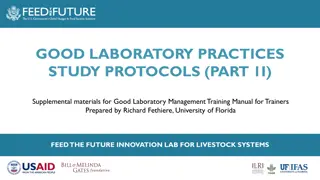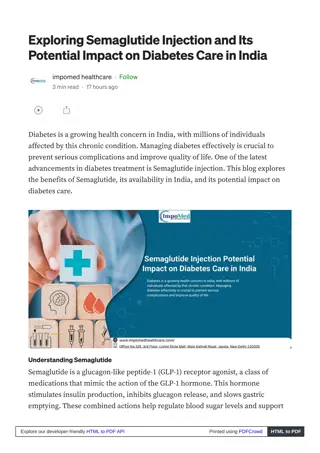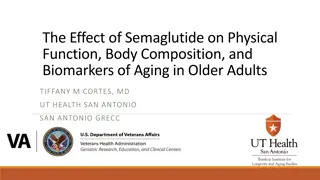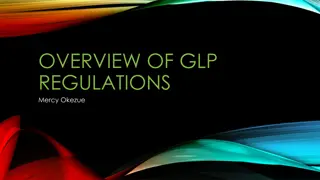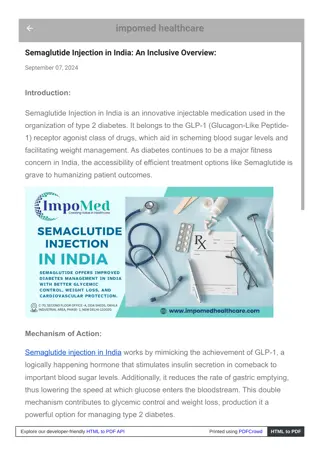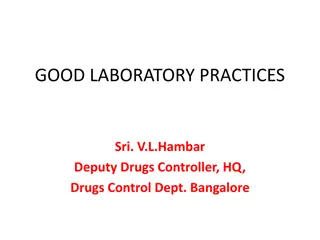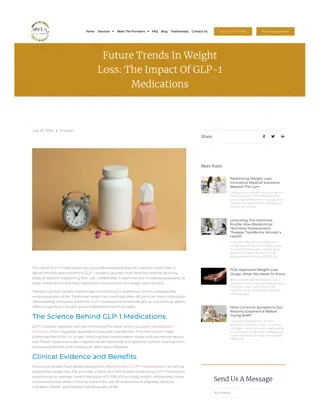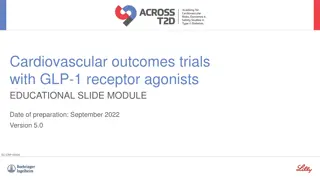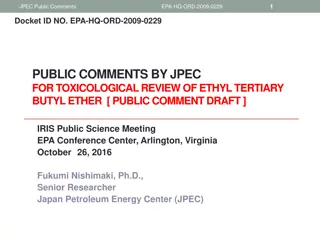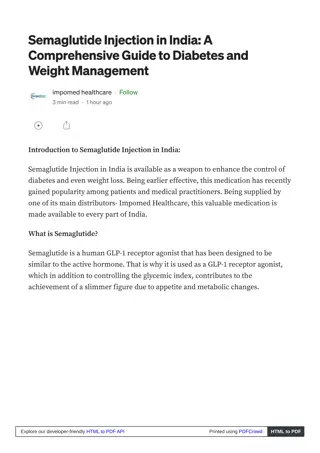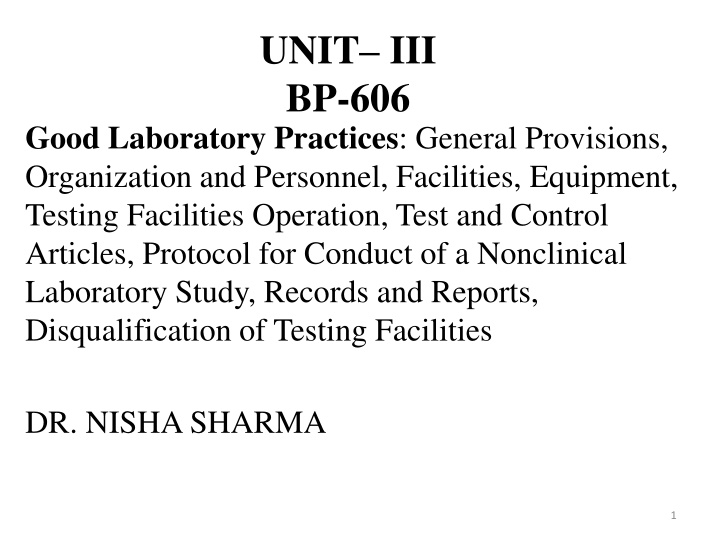
Good Laboratory Practices (GLP) in Safety Studies
Explore the fundamentals of Good Laboratory Practices (GLP) for non-clinical safety studies, including principles, regulations, and standards. Learn about the significance of GLP in ensuring data accuracy, research integrity, and quality reporting in various laboratory studies. Discover the key aspects of monitoring, planning, recording, archiving, and reporting in GLP-compliant studies. Gain insights into different classes of studies evaluating drug safety and the focus of GLP on reliability and traceability of data.
Download Presentation

Please find below an Image/Link to download the presentation.
The content on the website is provided AS IS for your information and personal use only. It may not be sold, licensed, or shared on other websites without obtaining consent from the author. If you encounter any issues during the download, it is possible that the publisher has removed the file from their server.
You are allowed to download the files provided on this website for personal or commercial use, subject to the condition that they are used lawfully. All files are the property of their respective owners.
The content on the website is provided AS IS for your information and personal use only. It may not be sold, licensed, or shared on other websites without obtaining consent from the author.
E N D
Presentation Transcript
UNIT III BP-606 Good Laboratory Practices: General Provisions, Organization and Personnel, Facilities, Equipment, Testing Facilities Operation, Test and Control Articles, Protocol for Conduct of a Nonclinical Laboratory Study, Records and Reports, Disqualification of Testing Facilities DR. NISHA SHARMA 1
INTRODUCTION TO GLP For validity of Non clinical safety data to FDA for NDA Establishment of final rules 21 CFR 58 Originated in USA 1970 s GL P defined as per OECD OECD GLP : Quality system with organizational process & conditions organization for economic co-operation & development 36 member countries founded in 1961 In GLP Studies are planned, performed, monitored, recorded, & reported For Non clinical health & Environmental safety 2
CFR: Code of Federal Regulations GLP: Good Laboratory Practices GCP: Good Clinical Practices GMP: Good manufacturing Practices 3
Quality system concerned with Principles GLP Ensures accuracy of data Integrity of research testing organizational process: planned, organized, performed, recorded & reported non clinical studies other lab studies/testing 4
Reliability Integrity of studies Principle of GLP uses Set of Standards to ensure Quality Reporting of verifiable conclusions Traceability of data 5
Monitoring Planning Recording Aspects of study execution Archieving Reporting 6
Classes of studies to evaluate drug safety Non clinical Studies In vitro /animal studies Single dose toxicity GLP applies to Repeated dose toxicity (sub acute/ chronic) Analytical aspects of these studies Reproductive Tox. (Fertility, teratogenicity, pre/post natal) Mutagenic potential To obtain data on properties or safety items important for human health/env Carcinogenic potential Toxicokinetics Pharmacodynamic Studies for adverse effects 7
Rules Results Characterization Quality assurance unit Focus of GLP Resources 8
General provisions Scope + Describes good laboratory practices for conduct of studies that support applications for research or marketing permits for human and veterinary drugs food and color additives medical devices chemicals pesticides 9
General provisions Definitions +Nonclinical Study experiment where drug/chemical is administered to animal in a lab to assess safety does not include exploratory studies or studies in humans +Sponsor person who initiates and supports a study, and who submits to FDA to ultimately support use of a drug/chemical in humans +Testing Facility person conducting a nonclinical study where dosing of drug to animal/plant +Study Plan/Protocol plan describing how to conduct an experiment or study 10
General provisions Definitions + Study Director individual responsible for the overall conduct of a non-clinical laboratory study (single point of control) + Test Item/Article any material given to an animal/ plant + Control Item/Article any material given as basis of comparison to test article + Test System any animal, plant, microorganism, or subpart of above which is given test and/or control item/article (i.e. drug/chemical) + Specimen any material taken from a test system for examination or analysis 11
General provisions Definitions + Study Initiation Date date Study Director signs the study plan/protocol + Study Completion Date date Study Director signs the final report + Quality Assurance Unit independent group tasked with assessing compliance and alerting SD and management to concerns + IND Investigational New Drug program means for obtaining permission to ship experimental drugs and assure that subjects will not be submitted to undue risk + NDA New Drug Application is the vehicle for FDA approval of a new pharmaceutical product for sale and marketing 12
General provisions Raw Data any laboratory worksheets, records, memoranda, notes, or exact copies thereof, that are the result of original observations and activities of a nonclinical laboratory study and are necessary for the reconstruction and evaluation of that study. Examples of Raw Data + Record of balance weight + Electronic food consumption data + Annotation describing condition of an animal + Identification of solution used to dilute + Record of equipment failure 13
Organization & Personnel DUTIES Management + Assign Study Director SD, replace if required * How do we know who the SD is for a study? + Test, control and reference items/articles are tested * Do we know what we are giving the animals? + QA Unit is in place *Is there an independent method of verifying compliance? + Resources are available * Do we have enough people, supplies, equipment to prepare, perform and monitor the study? 14
Management + Personnel understand their functions * Do staff know their responsibilities? + Deviations are communicated to SD and corrective action is taken * Are all SOP and study plan deviations documented in a timely manner and has action been taken to fix the situation? 15
Study Director + Overall responsibility for conduct of a study * How does SD oversee the study? How do they keep in touch with all study components? + Sign all protocols and protocol amendments * Why? + Ensure data are accurately recorded and verified * How does SD know this is done? + Circumstances that may affect quality and integrity of study are noted and corrective action is taken * How do SDs know that study is conducted such that integrity is maintained? How is corrective action taken? 16
Study Director + Test systems used are as specified in protocol * What Animal being used/age/weight? + GLP regulations are followed * How does an SD take on this huge responsibility? Study involvement/SOPs/Data Review/Impact assessment + Raw data, documentation, specimens, protocols and final report are transferred to archives at close of study * Who does this? 17
Organization & Personnel Quality Assurance Unit + Monitors studies to ensure that facilities, equipment, personnel, and procedures are in compliance with regulations * How does QA monitor? + Separate and independent from study conduct * Why is this necessary? + Maintains copy of master schedule and all protocols * Why does QA keep protocol copies? + Inspects at intervals adequate to assure integrity of study * What kind of inspections are done? 18
Quality Assurance Unit + Maintains written records of inspections * What will you see? + Report to management and SD on problems and action taken * How does this happen? + Determine that deviations from study plan/protocol or SOP were addressed * How does QA do this? Citations + Review final study report Reflective of the Data + Prepare and sign QA statement 19
PERSONNEL + Appropriate education, training and experience to perform duties * Employees should be competent in performing these duties + Maintain documentation of training * How do we document training? + Must have sufficient number of personnel for conduct of a study * Number should be reasonable for the size of study + Personnel shall take precautions to avoid contamination of test/control articles/items and test systems * What kind of precautions do we take? 20
Resources: Organization and Personnel Structure of Research Organization should be clear, Brief description of Organizational chart Responsibilities of Research Personnel clearly defined, recorded in job description profile Functions and relationships between different departments & posts should be given No. of personnel required to do a task in time should be made available Study director & study personnel must be appointed by test facility management 21
Responsibilities of director & personnel Identify individuals who can fulfill responsibilities as per GLP To ensure that facilities, equipments, materials, sufficient and qualified personnels are available in test facility for proper conduct of testing To maintain record of qualifications, training, experience, job description of each, technical staff involved in testing Establishing, maintaining and ensure Valid SOP s are followed To ensure and Formulation of QA program with designated personnel as per GLP Designation of appropriate personnels before study is initiated In case of multi site study, trained, qualified, experience principal investigators are designated to supervise the study Approval of study plan by study director 22
Responsibilities of director & personnel To make available the approved plan to the QA personnel Maintenance of master schedule Test facility supplies meet requirements necessary for study In multi study site: clear communication about study between director, PI, QA personnel & study personnel must be there Test and reference items are properly characterized Computerized systems are suitable for intended purpose and are validated, operated, maintained as per GLP The study director should take full responsibility of GLP compliance for all activities Evaluate the events & provide corrective measures if required Ensures that all raw data are fully documented & recorded Should sign with date the final report of study for validity 23
STUDY PERSONNEL Should be knowledgable in GLP principles applicable to the study involved Should have access to study plan & SOP s Should record the data immediately as per GLP Take health precautions for themselves Maintain the integrity of study Report any relevant health or medical condition to relevant person 24
Facilities + Suitable size and construction + Provide adequate separation to prevent activities from an adverse effect on study + Facilities for * animals (study and quarantine) * test and control items/materials * food, bedding and supplies * laboratory operation * waste disposal * specimen and data storage 25
FACILITIES + Archives specimen and data storage * Located beneath the Large Animals offices and tech room + Separate areas for storage of * paper and electronic records * specimens and test/control items/articles + Environment affords protection of materials + Retention time per GLPs and Study Plan/Protocol requirements 26
FACILITIES & EQUIPMENTS To do the studies sufficient facilities & good equipments as per GLP Provide Sufficient space for facility to avoid overcrowding, cross contamination etc Adequate & stable Water, electricity supply etc. Equipments etc must be working Records of equipments to know the status & history of their maintenance 27
Facilities: Buildings No disturbances, No interference of various activities So, separation of various activities Physical separation : walls, doors, filters, cabinets, isolators Organizational separation: Is different activities carried in same area then better to carry at different times, Allow cleaning & preparation between operations, maintaining separation of staff, define the work area in lab Ex: Receiving, storage, dispensing, weighing, mixing, dispatch areas in a Pharmacy & dose mixing Should be large enough to accommodate the staff with separate work stations, avoid cross contamination, allow easy movement etc. Construction material: should allow easy cleaning Proper ventilation 28
Animal Facilities Should minimize environmental variable on animals Provision of dirty and clean corridors to avoid contamination between new and old supplies Separate areas for different species, studies, quarantine, changing room, receipt of materials, storage of bedding, feed, test doses, cages etc. Cleaning equipments, Lab procedures, necropsy, Utilities, waste disposal etc. Separate Appropriate space for animals & studies Environment control system for temperature, Humidity, airflow according to animal species Surface of walls, doors, floors, ceilings- to allow easy, efficient cleaning 29
EQUIPMENT Equipment used in the generation, measurement, or assessment of data and equipment used for facility environmental control shall be of appropriate design and adequate capacity to function according to the study plan/protocol and shall be suitably located for operation, inspection, cleaning and maintenance. + Examples include balances, thermometers, pipettes, flow cytometers, refrigerators/freezers, HPLCs etc. GLP requires that we + Define how to use and maintain equipment + Inspect and clean equipment + Test, calibrate and/or standardize equipment + Perform routine and non-routine maintenance of equipment + Document how we will do this and who will do it + Write SOPs to detail methods, what will be documented, materials and schedules and the responsible individual 30
EQUIPMENT GLP requires that we document + Routine maintenance daily, weekly or otherwise * Non-routine maintenance (NRM) * Nature of the defect * How and when defect was discovered * Remedial action taken * NRM issues should be fully resolved 31
EQUIPMENT Purpose of GLP is to ensure reliability of data Decide Suitable equipments ex. To weigh animal a physical balance is sufficient instead of analytical balance Calibrationof all equipments as per the SOP s to the specifications need to done regularly to maintain standard conditions. Ex. In animal facility the conditioning of environment can be checked by using thermometer/ probes etc. Verification of equipments functionality should be checked periodically 32
EQUIPMENT Maintenance : 2 types: Preventive maintenance: based on the expected life of parts, as a preventive measure changing the part concerned. Reduces risk of sudden breakdown Curative maintenance: It is repair done when the equipment gets faulty. Mainly for computer based analyzers/ electronic balances. Contingency plans for failures like duplicate equipment, or availability of immediate maintenance technician. Vital backup like for power supply UPS for instruments and in case of animal house facility generator for power backup 33
TESTING FACILITY OPERATION Standard Operating Procedures A testing facility shall have standard operating procedures in writing setting forth nonclinical laboratory study methods to ensure the quality and integrity of the data generated Animal Care Animals of different species shall be housed in separate rooms when necessary. Animals of the same species, but used in different studies, should not ordinarily be housed in the same room when inadvertent exposure to control or test articles or animal mix-up could affect the outcome of either study. If such mixed housing is necessary, adequate differentiation by space and identification shall be made. 34
TESTING FACILITY OPERATION SOPs + Instructions for performing a duty + Approved by management + Always available for your review * Where are SOPs located? + Deviation from SOP requires * documentation in the data * authorization by the study director * statement of impact on study + Identify reagents by Identification Concentration Expiration date Storage conditions Deteriorated and outdated reagents and solutions should not be used 35
TESTING FACILITY OPERATION Animal Care + SOPs - housing, feeding, handling, care + Separation + Determine health status of animals upon arrival and prior to study initiation + Unique identification of animals + Provide clean conditions + Analysis of food, water and bedding + Document pest control + Basic animal care requirements in GLPs + Guide for the Care & Use of Laboratory Animals + Animal Welfare Act + Everyone s Responsibility + IACUC (Institutional Animal Care & Use Committee) * Review all study plans/protocols and any procedures to be performed on animals within or outside of a study 36
Test and Control Articles in Non clinical Laboratories studies + Characterization of test & control articles Certificate of Analysis Includes: Identity, strength, purity, composition determined & documented Documentation Methods of synthesis & production of each article Establish Stability of each article Proper labeling of Storage containers for articles Label include: name, chemical code no., batch no., expiration date, storage conditions etc Preserve the article samples for suitable period + Handling of test & control articles: SOP for handling in written form for proper identification, storage, receipt, distribution, of each batch of article + Mixing of article with carriers: Uniformity of mixing, stability of test in mixture to be assessed by analytical methods with proper documentation of results 37
Protocol for Conduct of a Nonclinical Laboratory Study What is Protocol? === It is a document describes principal steps necessary for conduct of a study as per GLP compliance Protocol includes: Design & conduct of study Evidence regarding proper thought & planned study Contains overall time schedule of study & various stages Indicates methods and materials to be used in study Key points to remember: Protocol must be approved by SD before starting the study Any amendments if required must be done with prior approval If a study is to be conducted by a CRO (contract research organization), protocol is a basis between sponsor & CRO It is the means of instruction to study staff 38
Contents of Protocol 1.Identification : Study to be given a unique ID no. all the documents records related to study should bear this ID no. 2. Title & statement of purpose: Title of study to be informative & short, include test item name i.e. name of investigational drug, type of study, duration of study, test system. Purpose of study to be indicated in protocol based on scientific & regulatory considerations 3. Identification of test & control substances: Name of chemical, its code, specs, characterization, stability data of test substance 4. Names & addresses of sponsor, test facility & test site: sponsor & test facility may be different organizations. Location must be indicated in protocol, if multi site study, then addresses of all sites to be included 5. Name of SD & other responsible person: Protocol must contain Name of SD, other scientists contributing significantly, for interpretation of data like pathologists, clinical pathologists. In multi site protocol name of Principal investigator of test site for conducting phase of the study at their site 39
Contents of Protocol 6. Proposed dates: Proposed dates of starting & finishing the study to be in protocol, Date of collection of first & last data 7. Justification for selection of the test system: If using animals, species & strain to be identified based on scientific test (as per OECD) guidelines. Justification on choosing test system which can be based on test facility background, strain concerned, & scientific & regulatory issues. 8. Description of the test system: If use of animals, should include species, strain, age, weight, source of animals, sex. Also describe the details of animal husbandary, environmental conditions (temp. humidity), types of cages, diet & its source etc. 9. Experimental design: includes: Dosing, Dose levels, route of dosing, frequency of dosing, vehicles used, method of preparation of dose conc., storage conditions of the formulation, QC, Animal assigned to groups, parameters to be examined, measured, statistical methods, data to be retained after the study 40
Records and Reports Preparing Final report after completion of study Reports by PI/ scientists involved- signed by date Final report- signed by SD- indicates acceptance of responsibility for validity of data Any corrections in final reports- in form of amendments Reason of changes in report, signed with date by SD Formatting as per submission requirements of various authorities can be done but without amendments 41
CONTENT OF FINAL REPORT 1. Identification of study, test article, reference item: Title Name & identification of reference article Identification of test article by code/ name (IUPAC, CAS no.) Characterization of Test article- Purity, stability, homogenity 2. Information related to sponsor & test facility: Name, address of sponsor Name & address of any test facilities & other test sites Name & address of SD Name & address of PI (Principal investigator/s) Phase/s of study details by investigator Name & address of scientists contributed to reports/ final 3. Starting & completion dates of study 42
CONTENT OF FINAL REPORT 4. Statement: Prepared by QA person about the QA program listing types of inspections made, dates of the inspections, phase inspected, dates of reporting inspection results to management/SD/PI 5. Description of test methods & materials used 6. Results: Summary of results Information & data required by the study Calculations & determinations of statistical significance Evaluation & discussion of the results Conclusions 7. Storage: Final report must include the locations where study plan, samples of test, reference article, specimens, raw data & final report will be stored. 43
DISQUALIFICATION OF NON CLINICAL TESTING FACILITIES 1. Any data generated by a testing facility which does not comply GLP regulations, then it will be excluded for consideration 2. Disqualification of testing facility can be due to Failure to comply 1 or more relevant GLP regulations If non compliance adversely affects the validity of Study Actions like warning or rejections of individual studies will not be considered to qualify 3. If testing facility found to be disqualified, FDA issues a notice & invites from the testing facility for any explanations 4. The final order on disqualification or its termination depends on FDA after it satisfies via hearing/ evaluating the records 44
DISQUALIFICATION OF NON CLINICAL TESTING FACILITIES 5. If any data generated after the disqualification of testing facility, the FDA will not consider the application for product approval 6. If any testing facility is disqualified by FDA, then it may again apply for reinstating with due justifications, and undertake that it will conduct & comply future non clinical studies in as per GLP. FDA may reinstate lab upon satisfaction 45



